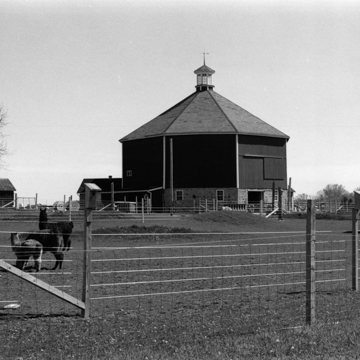In the late 1890s, Ernst Clausing built at least eight octagonal barns in the towns of Mequon and Grafton, but only these two remain. Clausing, the son of Prussian immigrants and a hardware proprietor, descended from the “48ers,” who left Germany during social upheavals. But unlike others who built barns in the styles of their homeland, even as late as the 1890s, Clausing chose a modern approach recommended by Franklin Hiram King of the Wisconsin Agricultural Extension Service. King argued that round and octagonal barns withstood high winds well and were more efficient. Octagons were easier and therefore cheaper to build than true round barns, which may have influenced Clausing’s choice.
He built these two nearly identical barns for two of his relatives. Like all octagonal barns, both are two-story basement barns, so called because the haymow rests on a basement, where the cattle lived. Clausing constructed the basement walls of fieldstone and provided ample windows, reflecting the belief that sunlight promoted healthy cows and a germ-free environment. Vertical wooden siding clads the mow, which has a ramp to allow the farmer to drive his wagon directly into it. Both barns incorporate a central silo, marked by an octagonal ventilator at the center of the roof. The tall cupola on Theodore and Mary Clausing’s barn looks almost classical, with multipaned windows.


